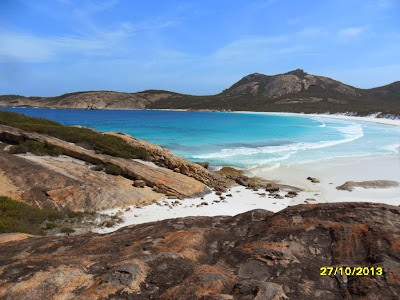Australia Aug-Nov 2013
Travelogue 14 Stage 3
Perth-Esperance
We
stored our car and caravan and left Perth for New Zealand in
December, 2011. Due to circumstances, we were not able to return to
Perth until August 3rd
2013, some twenty months later. But that's another story.
Perth
was as we had left it, though with atrocious weather further south,
we stayed put for over a month, earning a little money painting, had
repairs done to our car, met and made friends with many hospitable
folk and enjoyed new sights and adventures in and around Perth.
October
4th,
we finally left Perth for the southern coast. It was a little sad as
we'd made many friends who could not really believe we would leave.
But our time had come. We said our goodbyes and were soon on the
road.
 |
| Cape Leeuwin - note Captain Cow. |
Inland
through heavily forested areas, staying overnight at Pemberton then
Walpole, our next major stop was Denmark, a pretty town on the south
coast, detouring on the way to visit the Valley of the Giants Treetop
Walk where one walks a steel-grilled walkway 45 metres above the
forest floor, viewing the tall karri trees and rare giant tingle
trees, which grow only around this area. Adjacent is the Ancient
Kingdom, full of beautiful paths and buttressed tingle trees, some
with burnt hollow centres cause by lightning. The trees
themselves
were not distressed, for this is part of their natural makeup.
 |
| Hollow giant tingle tree, Walpole |
Our
stay in Denmark's caravan park was enriched with visits by about
thirty kangaroos each evening, and waking each morning to the
laughter of kookaburras. Ten kilometres distant was Greens Pool,
where a naturally occurring wall of huge rounded boulders about 100
metres off-shore protects the bay from ocean swells, making this
sandy bay safe, shallow and warm with clear waters – the ideal spot
for Bryan's first swim of the season.
On
to historic and busy Albany, southernmost city of Western Australia
where we stocked up for the days ahead. Don't go shopping there on a
Saturday afternoon, or Sunday. Everything shuts, including the
supermarkets.
 |
| Stonehernge, Esperance, WA |
We
had been recommended to stay at Cape Le Grand National Park, fifty
kilometres from Esperance. Saturday 26th
October, we drove to stay at Lucky Bay, one of two camping areas
within this huge park. Being a national park, there is no power, but
there were solar-powered hot showers, flush toilets and gas
barbecues, and lots of happy hours with other like-minded campers.
Each night became a circle of twenty or more fellow campers, each
retelling the best walks that day, or best spot for phone reception.
Whenever
opals are created, their colours must come from the opalescent
waters of Lucky
Bay. Here, the sea is topped with pearl-like surf.
Between each lazy wave one can see perhaps eight to ten metres
through translucent green water to the white sandy bottom. This area
is considered to have the whitest sand in Australia, bettering that
of Whitehaven Beach in the Whitsunday Islands, Queensland. About 250
metres offshore, the water changes markedly to the deepest
ultramarine blue, and beyond that, bare islets of burnt orange
granite stand naked against the sky. At night, the stars shine with
a brilliance unseen in any city.
 |
| Lucky Bay - this photo has not been retouched |
Inland,
the park also has many bare and high granite outcrops, one known as
Frenchman Peak. At 262 metres, it's a steep, if not scary, 40 degree
45 minute climb to the top, our reward being an uninterrupted view
across this massive park. From the peak, this outcrop
drops very
steeply on all sides. At the peak itself, one massive rock of
several thousand tonnes forms a natural bridge over a very large
open-ended cavern. Inside, swallows make their home with their noisy
comings and goings. From ground level, you can look right through
this outcrop.
 | |
| Frenchman Peak - note the open cavern near the top |
 |
| Cape Le Grand |
Our
six days there only came to an end when we learned rain was on the
way. We're now back in Esperance stocking up for our next stage,
Esperance to Adelaide. We hope you can join us.



What a grand journey, great to see you two are still being surprised by the beauty of your trip. Go well and keep up the good blog x
ReplyDelete